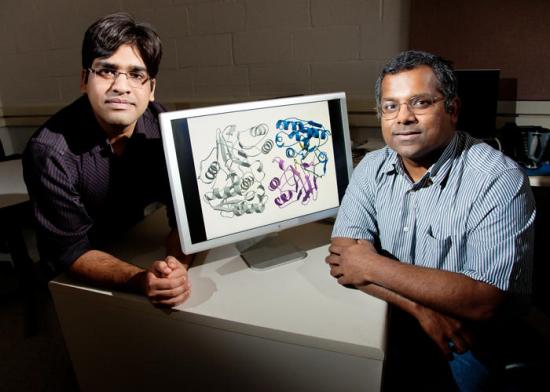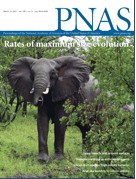导读:最近来自国外的一项研究发现,细菌可以利用一种未知的方式来抵制抗生素对其的伤害,研究者们发现这种细菌可以修饰自身的管家酶(housekeeping enzyme),进而使得自己的管家酶识别作用的抗生素,并且使得抗生素“缴械投降”。这项研究刊登在了新一期的国际著名杂志PNAS上。

不同的细菌之间通常进行的是化学战斗(信号分子互相影响),用于药品中的很多抗生素都是细菌保护自己的武器,但是细菌通常会保护自身不受自身毒素的伤害,这种自身保护防御的能力往往会被别的种所学习而获得,慢慢地,就产生了细菌的耐药性。研究者们将注意力集中到一种称为MccF的酶上,这种酶可以使得特洛伊木马抗生素("Trojan horse" antibiotic)失活,这种抗生素可以渗入到细胞中,以一顿丰盛的蛋白晚餐的形式隐藏起来。而细菌中一种被称为C7(McC7)的抗生素和一系列用于治疗皮肤感染的抗生素类似。研究者Satish Nair表示,一般情况下,特洛伊木马抗生素部分会和某些无害的物质进行耦合,以此形成一种肽,因此当敏感的细菌看到这种肽的时候,便以为是美味的食物,将其吞下去;细菌享用这顿美味的代价是相当高的,有可能使其送命,一旦细菌体内的酶将抗生素暴露出来之后,抗生素便会自由地攻击细菌体内蛋白质合成的任何一个关键组分,从而引起细菌死亡。
这就是为什么细菌要改变自身的基因,进而改变基因所编码的酶来抵御抗生素对细菌的伤害,以前的研究中,研究者发现了保护细菌免受抗生素伤害的一些基因,但是具体机理并不清楚,这些基因所编码产生的肽酶可以正常的消化多肽,但是同时也缺乏是被任何多肽的能力。Nair指出,以前的研究中,我么么并不清楚多肽酶是如何来破坏抗生素的,为了进一步研究肽酶的结构,研究者将MccF酶结晶出来,MccF可以和抗生素进行结合,通过分子结构以及与抗生素结合反应的分析,研究者表示MccF和其家族的酶类有些类似,但是MccF携带了一个氨基酸附加环,便于识别抗生素,阻碍抗生素发挥作用,进而使其失活。
研究者Nair表示,MccF环上特殊的氨基酸残基在识别抗生素并且降解抗生素方面发挥着主要的作用,因此,我们就可以扫描致病细菌的所有基因组,然后寻找到那些携带有抗性环(antibiotic-resistance loop)的基因,这样一来,我们知道了哪种疾病是因为哪种细菌感染而引起的,我们就可以准确地进行用药,而不是盲目用药以至于细菌产生耐药性。

Structure and function of a serine carboxypeptidase adapted for degradation of the protein synthesis antibiotic microcin C7
Vinayak Agarwala,b, Anton Tikhonovc,d, Anastasia Metlitskayac, Konstantin Severinovc,d,e, and Satish K. Naira
Several classes of naturally occurring antimicrobials exert their antibiotic activity by specifically targeting aminoacyl-tRNA synthetases, validating these enzymes as drug targets. The aspartyl tRNA synthetase “Trojan horse” inhibitor microcin C7 (McC7) consists of a nonhydrolyzable aspartyl-adenylate conjugated to a hexapeptide carrier that facilitates active import into bacterial cells through an oligopeptide transport system. Subsequent proteolytic processing releases the toxic compound inside the cell. Producing strains of McC7 must protect themselves against autotoxicity that may result from premature processing. The mccF gene confers resistance against endogenous and exogenous McC7 by hydrolyzing the amide bond that connects the peptide and nucleotide moieties of McC7. We present here crystal structures of MccF, in complex with various ligands. The MccF structure is similar to that of dipeptide LD-carboxypeptidase, but with an additional loop proximal to the active site that serves as the primary determinant for recognition of adenylated substrates. Wild-type MccF only hydrolyzes the naturally occurring aspartyl phosphoramidate McC7 and synthetic peptidyl sulfamoyl adenylates that contain anionic side chains. We show that substitutions of two active site MccF residues result in a specificity switch toward aromatic aminoacyl–adenylate substrates. These results suggest how MccF-like enzymes may be used to avert various toxic aminoacyl–adenylates that accumulate during antibiotic biosynthesis or in normal metabolism of the cell.








